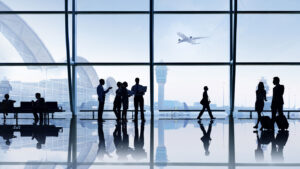
With large flows of people coming and going, security is of paramount importance to airport operators. Keeping unauthorized or dangerous individuals out of restricted areas with a robust access control system is crucial.
Passenger and staff safety is a major priority for airports, and operators are turning to advanced technologies, such as video surveillance backed with advanced analytics, IoT-related solutions and advanced networking equipment, to keep their facilities secure. Demand for airport security products is picking up, with Global Market Insights estimating that the market will increase from US$9 billion in 2016 to $16 billion by 2024, at a compound annual growth rate of 7 percent.
At the heart of airport security is access control. When we talk about airport security, the main concern related to access control is the challenge of allowing only those with approved access to restricted areas on the property. In busy airports, this can be a real challenge. Access control solutions, as well as their integration with other data management platforms, are paramount to ensuring proper levels of access are maintained across the facility.
The challenge is that most employees do not work for the airport; they work for the airlines, TSA, or a vendor that resides within the airport. Access control systems allow airports to create partitions between vendors and determine who should and should not have access to certain areas.
Key areas that need to be protected
In an airport there are various critical and sensitive areas that need to be secured. Airports have several restricted zones where only authorized personnel should be allowed to access, to maintain security standards. Areas include: the tarmac, to avoid hindering take-off or landing procedures; the hangars, to prevent any aircraft tampering; the data centers where sensitive information is stored; and traffic control towers which regulate aircraft flows, and baggage areas. Boarding/deplaning areas are also sensitive zones which require access control. As they are part of an airport’s effort to enforce border control, segregation between arrival and departure passengers is important.
Areas such as inside baggage claim, access to the tarmac, control rooms and towers all must be protected with an access control system. People who intend to do maximum harm to these types of facilities will seek to gain access to these areas.
There needs to be strict access control around sensitive areas such as the command and control center and also baggage handling areas. With luggage being a key target for terrorists or smugglers, it’s vital that suitable protection is in place. Another area that needs excellent security is the retail facilities. Modern airports have a huge amount of retail and hospitality space containing valuable goods and stock. With the public able to access many of these areas, it’s important that goods are protected from theft or tampering.
Multifactor authentication can add an extra layer of security by requiring employees to both present a badge and enter a PIN. If an employee loses a badge, a perpetrator cannot open a door without a PIN. Increasing use of advanced biometrics is now being used including facial recognition.
Source: a&s Magazine



































































